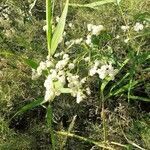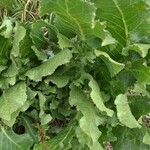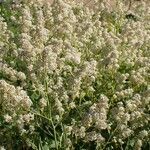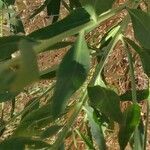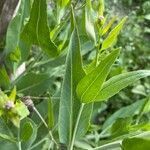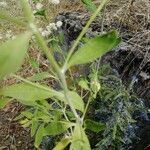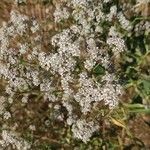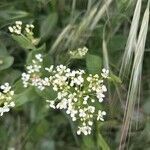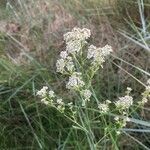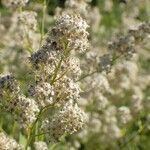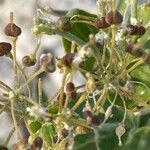Perennials; (rhizomes thick, caudex woody); glabrous or pubescent. Stems simple from base, erect, branched distally, (2-)3.5-12(-15) dm. Basal leaves not rosulate; petiole 1-9 (-14) cm; blade elliptic-ovate to oblong, (2-)3.5-15(-25) cm × (5-)15-50(-80) mm, (leathery), margins entire or serrate. Cauline leaves sessile or shortly petiolate; blade oblong to elliptic-ovate or lanceolate, (1-)2-9(-12) cm × 3-45 mm, base cuneate, not auriculate, margins serrate or entire. Racemes (subcorymbose panicles), slightly elongated or not in fruit; rachis glabrous or sparsely puberulent, trichomes straight, cylindrical. Fruiting pedicels ascending to divaricate, straight or slightly curved, (terete), 2-5(-6) × 0.1-0.2 mm, glabrous or puberulent adaxially. Flowers: sepals suborbicular to ovate, 1-1.4 × 0.8-0.9 mm; petals white, obovate, 1.8-2.5 × (0.8-)1-1.3 mm, claw 0.7-1 mm; stamens 6; filaments 0.9-1.4 mm, (glabrous); anthers 0.4-0.5 mm. Fruits oblong-elliptic to broadly ovate or suborbicular, (1.6-)1.8-2.4(-2.7) × 1.3-1.8 mm, apically not winged, apical notch 0(-0.1) mm deep; valves thin, smooth, not veined, glabrous or sparsely pilose; style 0.05-0.15 mm, exserted beyond apical notch (when present). Seeds oblong, (0.8-)1-1.2 × 0.6-0.9 mm. 2n = 24.
Perennial herbs, stoloniferous; stems erect, 50–130 cm high, glabrous. Basal leaves ovate, simple to pinnately-lobed, up to 30 cm long and 6 cm wide, serrate, shortly petiolate; cauline leaves reducing to narrowly elliptic, entire and bract-like; leaves often sparsely hairy with weak, simple hairs. Inflorescence a terminal panicle. Sepals 1–1.5 mm long, spreading, the hairs weak, fine, simple; margins petaloid. Petals 2–3 mm long, clawed, white. Stamens 6. Style slightly exserted; stigma capitate. Silicula dehiscent, broadly ovate, not winged or notched, c. 2 mm diam., sparsely hairy, the hairs as on sepals; pedicels mostly 4–5 mm long, spreading, terete, weak. Seeds 1–1.3 mm long, elliptic; radicle incumbent.
Rhizomatous perennial to 2 m; herbage glabrous or nearly so; lower lvs long-petioled, to 30 × 8 cm; cauline lvs lanceolate to narrowly ovate, entire to dentate, the main ones 1–4 cm wide; infl paniculately branched, with many short racemes that do not elongate; stamens 6; fr sparsely hirsutulous, suborbicular, 2 mm, wingless, rounded at both ends, not notched; stigma subsessile; 2n=24. Native of s. Europe and w. Asia, established along the coast from Mass. to L.I. and at widely scattered stations elsewhere.
A cabbage family herb. It is a perennial plant about 1 m high. It can spread per year by an invasive root system. The leaves near the base have long leaf stalks. The leaves on the stems do not have stalks. They are also long. They are 1-9 cm long by 0.3-4.5 cm wide. The flowers are white. There is no notch at the tip of the fruit. There are some named cultivated varieties.
